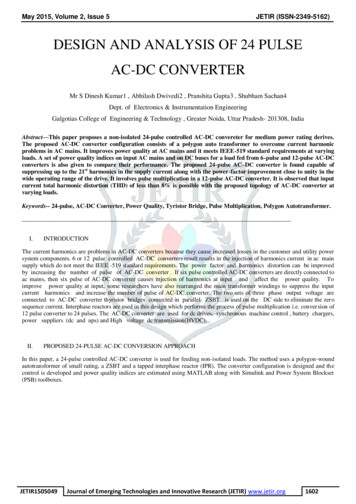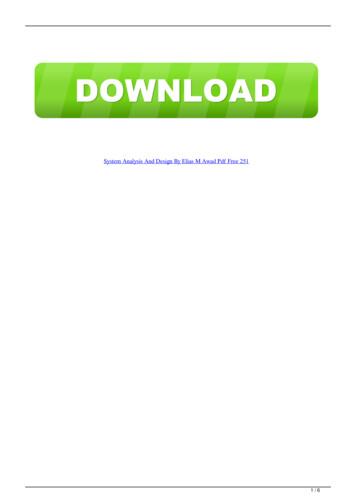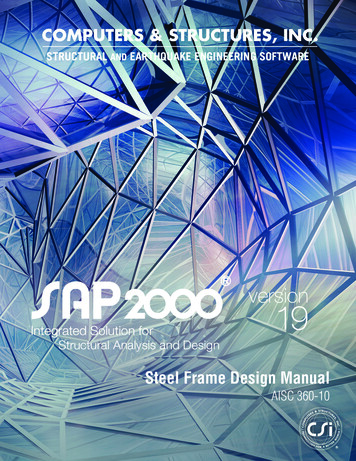
Transcription
May 2015, Volume 2, Issue 5JETIR (ISSN-2349-5162)DESIGN AND ANALYSIS OF 24 PULSEAC-DC CONVERTERMr S Dinesh Kumar1 , Abhilash Dwivedi2 , Pranshita Gupta3 , Shubham Sachan4Dept. of Electronics & Instrumentation EngineeringGalgotias College of Engineering & Technology , Greater Noida, Uttar Pradesh- 201308, IndiaAbstract—This paper proposes a non-isolated 24-pulse controlled AC-DC convereter for medium power rating derives.The proposed AC-DC converter configuration consists of a polygon auto transformer to overcome current harmonicproblems in AC mains. It improves power quality at AC mains and it meets IEEE-519 standard requirements at varyingloads. A set of power quality indices on input AC mains and on DC buses for a load fed from 6-pulse and 12-pulse AC-DCconverters is also given to compare their performance. The proposed 24-pulse AC–DC converter is found capable ofsuppressing up to the 21st harmonics in the supply current along with the power-factor improvement close to unity in thewide operating range of the drive. It involves pulse multiplication in a 12-pulse AC-DC converter. It is observed that inputcurrent total harmonic distortion (THD) of less than 8% is possible with the proposed topology of AC-DC converter atvarying loads.Keywords-- 24-pulse, AC-DC Converter, Power Quality, Tyristor Bridge, Pulse Multiplication, Polygon Autotransformer.I.INTRODUCTIONThe current harmonics are problems in AC-DC converters because they cause increased losses in the customer and utility powersystem components. 6 or 12 pulse controlled AC-DC converters result results in the injection of harmonics current in ac mainsupply which do not meet the IEEE -519 standard requirements. The power factor and harmonics distortion can be improvedby increasing the number of pulse of AC-DC converter . If six pulse controlled AC-DC converters are directly connected toac mains, then six pulse of AC-DC converter causes injection of harmonics at input and affect the power quality. Toimprove power quality at input, some researchers have also rearranged the main transformer windings to suppress the inputcurrent harmonics and increase the number of pulse of AC-DC converter. The two sets of three phase output voltage areconnected to AC-DC converter thyristor bridges connected in parallel. ZSBT is used on the DC side to eliminate the zerosequence current. Interphase reactors are used in this design which performs the process of pulse multiplication i.e. conversion of12 pulse converter to 24 pulses. The AC-DC converter are used for dc drives, synchronous machine control , battery chargers,power suppliers (dc and ups) and High voltage dc transmission(HVDC).II.PROPOSED 24-PULSE AC-DC CONVERSION APPROACHIn this paper, a 24-pulse controlled AC-DC converter is used for feeding non-isolated loads. The method uses a polygon-woundautotransformer of small rating, a ZSBT and a tapped interphase reactor (IPR). The converter configuration is designed and thecontrol is developed and power quality indices are estimated using MATLAB along with Simulink and Power System Blockset(PSB) toolboxes.JETIR1505049Journal of Emerging Technologies and Innovative Research (JETIR) www.jetir.org1602
May 2015, Volume 2, Issue 5JETIR (ISSN-2349-5162)Figure 1: Block diagram of 24-pulse AC-DC convertera)DESIGN OF THE AUTOTRANSFORMER FOR 12-PULSE AC-DC CONVERTERSThe minimum phase shift required for proper harmonicelimination is given by [5]phase shift 60 /number of converters.For achieving 12-pulse ac–dc conversion, the phase shift between the two sets of voltages may be either of 0 and 30 or 15 with respect to the supply voltages. In this paper, the autotransformer based on 15 phase shift has been considered to reduce thesize of the magnetics. From the supply voltages, two sets of 3-phase voltages (phase shifted through 15 and 15 ) are produced.The number of turns required for 15 and 15 phase shift are calculated. The number of turns for every winding is determinedas a function of the primary phase voltage, VA. Fig. 2 shows the winding-connection diagram of the proposed polygonautotransformer.V’a Va K1Vc K2Vb(1)V’a Va K1Vb K2Vc.(2)JETIR1505049Journal of Emerging Technologies and Innovative Research (JETIR) www.jetir.org1603
May 2015, Volume 2, Issue 5JETIR (ISSN-2349-5162)Figure 2: Polygon autotransformerAssume the following set of voltages:Va V 00, Vb V 1200, Vc V 1200(3)V’a V 150, V’b V 1050, V’c V 1350(4)Where Va, Vb, and Vc are the phase voltages.Similarly,V’a V 150, V’b V 1350, V’c V 1050(5)Where V is the rms value of the phase voltage. Using the above equations, K1 and K2 can be calculated. These equations result inK1 0.1835 and K2 0.1153 for the desired phase shift in the autotransformer. ThusV’a Va 0.1835Vc 0.1153Vb(6)V’a Va 0.1835Vb 0.1153(7)A phase-shifted voltage V’a is obtained by tapping a portion (0.1835) of phase voltage Vc and connecting one end of anapproximate (0.1153) of the phase voltage Thus, the autotransformer can be designed with these known values of windingconstant K1 and K2.Due to the 24-pulse operation, the average voltage at dc link is higher than the output voltage of a 6-pulsediode-bridge rectifier by about 2.8%. The proposed autotransformer design is modified to make it suitable for retrofitapplications. The kilovoltampere rating of the transformer is calculatedEquivalent KVA rating 0.5(8)where Vwinding is the voltage across each winding of the autotransformer, and Iwinding is the current flowing through the samewinding at full load.b) BRIDGE CONTROLLED RECTIFIERA rectifier is an electrical device that converts alternating current (AC), which periodically reverses direction, to direct current(DC), which flows in only one direction. The process is known as rectification. The simple process of rectification produces atype of DC characterized by pulsating voltages and currents (although still unidirectional). Depending upon the type of end-use,this type of DC current may then be further modified into the type of relatively constant voltage DC characteristically producedby such sources as batteries and solar cells. Rectifiers have many uses, but are often found serving as components of DC powersupplies and high-voltage direct current power transmission systems.JETIR1505049Journal of Emerging Technologies and Innovative Research (JETIR) www.jetir.org1604
May 2015, Volume 2, Issue 5JETIR (ISSN-2349-5162)SIX PULSE BRIDGE RECTIFIER-Figure 3: Bridge controlled rectifierA six-pulse controlled bridge rectifier connected to an ideal three-phase source with commutating inductances included in eachphase. First considering the operation of an uncontrolled rectifier without commutating inductances circuit as shown in figureexcept the thyristors are replaced by diodes and the inductors are removed. Without commutation, only two diodes will conductat any time, one on the top half of the bridge and one on the bottom half of the bridge. Also in order to have a voltage across theload, the two conducting diodes must be in different legs of the bridge e.g. diodes 1 and 4 cannot be on at the same time. Thusthe voltage applied to the DC load consists of a portion of a line to line voltage from the three phase source.c)ZERO SEQUENCE BLOCKING TRANSFORMERThe zero sequences blocking transformer is used for controlled 24-pulse AC-DC converter. The function of ZSBT is used inachieving independent 6-pulse operation of the two rectifier bridges, which eliminates the unwanted conducting sequence of therectifier diodes or thyristors. It exhibits high impedance to zero-sequence currents. ZSBT is used on the DC side for power qualityimprovement. It is also used for independent operation of two bridges and eliminates the unwanted conducting sequences ofthe converter. In non isolated AC-DC converters; a path for zero sequence currents is available through the autotransformerwindings. It leads to unequal conduction in upper and lower thyristors of the two bridges. This theory has been used to design acompletely new and innovative transformer that integrates the treatment of zero sequence harmonics as well as 5th & 7thharmonics. These transformers may be configured as single or multiple output units to accommodate various design strategies.The function of ZSBT is used in achieving independent. It exhibits high impedance to zero-sequence currents, resulting in 120 conduction for each diode of the bridges and also results in equal current sharing in the output. Moreover, it exhibits highimpedance to zero-sequence currents, thereby allowing symmetrical conduction of each diode. The voltage across ZSBT dependson the conduction sequence of the diodes, and it is shown in Fig. 7. Mathematically, VZSBT can be expressed as [8]VZSBT(ωt) VLL { 0.25 cos(3ωt) 0.07sin(6ωt) 0.03 cos(9ωt) · · ·}.(9)The previous equation shows that the lowest frequency component of the voltage waveform across ZSBT (VZSBT) is 150 Hz, i.e.,corresponding to the third harmonic, and it contains only triplen harmonics, as shown in Fig. 7. This results in smaller size,weight, and volume of the transformer. Here, VLL is the rms supply-line voltage.Figure 4: ZSBT diagramd) INTERPHASE REACTORJETIR1505049Journal of Emerging Technologies and Innovative Research (JETIR) www.jetir.org1605
May 2015, Volume 2, Issue 5JETIR (ISSN-2349-5162)The interphase reactor, along with the two diodes, is shown in the fig. it shows that, when the voltage V m is positive, the diode D1becomes forward biased, and the full-load current flows through this diode.Figure 5: IPR diagramA required condition to achieve the pulse doubling is to ensure that the instantaneous output voltages of the two converters, D1and D2, are the same and displaced by an angle of 300. Therefore, depending on the polarity of voltage Vm, the magnitudes of theconverter output currents are modulated and this changes the shape of the rectifier input currents and, thereby, doubles the pulses.From the magneto motive force (MMF) relationship of the interphase reactor, it can be written asId1 (0.5 k)idc(10)Id2 (0.5 – k)idc(11)Similarly, when the voltage Vm is negative, diode D2 becomes forward biased, and the full-load current flows through this diode.From the MMF relationships of the interphase reactor, it can be written as,Id1 (0.5 - k)idc(12)Id2 (0.5 k)idc(13)It is observed that the polarity of the voltage V m modulates the output current id1 and id2. Therefore, depending upon the polarityof the impressed voltage across the interphase reactor, diodes D1 or D2 conduct, resulting in pulse doubling. The value of k hasbeen selected to be 0.26 to eliminate the harmonics up to the 22 nd order. The voltage appearing across the interphase reactor Vm isan AC voltage ripple of six times the source frequency, resulting in smaller size, weight, and volume of the transformer. Fig.shows the waveform of the diode currents showing the changeover of currents through the diodes, and this results in achievingthe 24-pulse characteristics. Two bridge output voltages vdc1 and vdc2 rectifier output voltage vdc is given byvdc 1/2(vdc1 vdc2)(14)Similarly, the voltage across the interphase reactor is given byvm vdc1 vdc2(15)where vm is an ac voltage ripple of six times the source frequency.III.MATLAB BASED SIMULATIONA set of 6-pulse, 12-pulse and 24–pulse AC-DC converters are modeled and simulated in a MATLAB environment along withSimulink and Power System Blockset (PSB) toolboxes.JETIR1505049Journal of Emerging Technologies and Innovative Research (JETIR) www.jetir.org1606
May 2015, Volume 2, Issue 5JETIR (ISSN-2349-5162)Figure 6: MATLAB model of 24-pulse AC-DC converter.IV.RESULTS, DISCUSSION AND CONCLUSIONThe power quality indices from simulation of the proposed controlled 24-pulse AC-DC converter are given in table in comparisonwith that of 12-pulse AC-DC converter. It can be seen that the load power at a 75o firing angle is around 6% of the full load and avalue of the firing angle above 60o will be required during transient conditions only. It can be seen in fig 7 that the input current(ia) has 24 step in one cycle of AC supply. The improvement in power quality indices, such as THD of supply current(THD),THD of supply voltage (THD),distortion factor and PF, at different firing angles is shown in fig 8. It can be seen that theTHD of the input AC current of the proposed 24-pulse AC-DC converter system is less than 5% and the current waveform isalmost sinusoidal and in phase with the supply voltage. It can be observed that the 24-pulse AC-DC converter has a significantlyimproved performance. The value of THD at PCC is higher than that desired from a 24 pulse AC-DC converter due tocommunication notches.JETIR1505049Journal of Emerging Technologies and Innovative Research (JETIR) www.jetir.org1607
May 2015, Volume 2, Issue 5JETIR (ISSN-2349-5162)Figure 8: THD and Power Factor of 24-pulse AC-DC converterFigure 9 : input current and total harmonic distortionJETIR1505049Journal of Emerging Technologies and Innovative Research (JETIR) www.jetir.org1608
May 2015, Volume 2, Issue 5JETIR (ISSN-2349-5162)Figure 7: Input and output waveforms of 24-pulse controlled AC-DC converterV.REFERENCES[1] P. Vas, Sensorless Vector and Direct Torque Control, Oxford University Press, 1998.[2] Limits for Harmonic Current Emissions, International Electrotechnical Commission Standard 61000-3-2, 2004.[3] IEEE Guide for Harmonic Control and Reactive Compensation of Static Power Converters, IEEE Standard 519-1992.[4] D. A. Paice, Power Electronic Converter Harmonics: Multipulse Methods for Clean Power, New York: IEEE Press, 1996.[5] Bin Wu, High-Power Converters and AC Drives, IEEE Press, Wiley-Interscience, 2006.[6] S. Choi, P. N. Enjeti, and I. J. Pitel, “Polyphase transformer arrangements with reduced kVA capacities for harmonic currentreduction in rectifier type utility interface”, IEEE Trans. on Power Electronics, Vol. 11, No. 5, pp. 680–689, September 1996.[7] P. W. Hammond, “Autotransformer”, U.S. Patent No. 5619407, April 8, 1997.[8] D. W. Owens, “Autotransformer for Use with Multiple Phase Rectifiers”, US Patent 7049921, May 23, 2006.[9] S. Choi, B. S. Lee, and P. N. Enjeti, “New 24-pulse diode rectifier systems for utility interface of high power AC motordrives”, IEEE Trans. on Industry Applications, Vol. 33, No. 2, pp. 531–541, March/April 1997.[10] B. Singh, G. Bhuvaneswari, V. Garg, “Power-quality improvements in vector-controlled induction motor drive employingpulse multiplication in AC-DC converters” IEEE Trans. on Power Delivery, vol. 21 no. 3, pp. 1578 –1586, July 2006,JETIR1505049Journal of Emerging Technologies and Innovative Research (JETIR) www.jetir.org1609
.Due to the 24-pulse operation, the average voltage at dc link is higher than the output voltage of a 6-pulse diode-bridge rectifier by about 2.8%. The proposed autotransformer design is modified to make it suitable for retrofit applications. The kilovoltampere rating of th











